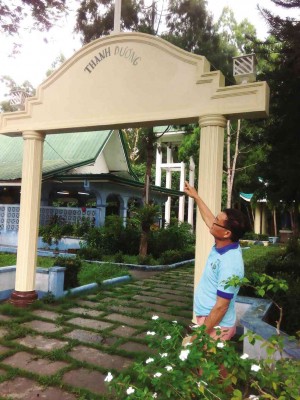A sentimental journey for Viet ‘boat people’

FR. PAUL Van Chi Chu, former assistant chaplain at the refugee camp, Bishop Pedro Arigo and other former refugees distribute goods to poor families in Puerto Princesa City. PHOTOS BY REDEMPTO D. ANDA/INQUIRER SOUTHERN LUZON
PUERTO PRINCESA CITY—About 80 Vietnamese, mostly former refugees and asylum seekers who had lived here while awaiting for repatriation to a third country, came back on Friday on a sentimental journey for the first time since their camp was closed two decades ago.
“We are so glad to be back. It has been many years and we had always wanted to come back here to pay our gratitude to the Filipino people who took care of us,” Fr. Paul Van Chi Chu, a Catholic priest and former assistant chaplain at the Vietnamese Refugee Camp (VRC), told the Inquirer.
The group of mostly professionals now living in the United States, Canada, Australia, Germany and the Netherlands, and some in Vietnam, came for a three-day tour of Puerto Princesa to visit familiar landmarks, meet local friends and acquaintances and distribute goods to poor families in Barangay Santa Lourdes.
“This brings back both painful and happy memories,” said Bishop Pedro Arigo, who welcomed them for lunch at VietVille Restaurant inside a 10-hectare property, which was established by the city government and the Catholic Church as a Vietnamese settlement following the closure of the refugee program by the United Nations (UN) in 1996.
Tolerant policy
Article continues after this advertisementHai Duong, in his mid 50s, recalled that he came with his brother to Palawan in a boat that had escaped from Vietnam after the fall of Saigon. “We were orphans and you adopted us,” he said.
Article continues after this advertisementDuong said he stayed in the camp for over a year before he was accepted to Australia, where he studied and finished engineering. After graduation, he volunteered as a UN worker.
He described the VRC, located beside the headquarters of the Armed Forces of the Philippines’ Western Command (Wescom) in Barangay Bancao-Bancao, as “a very beautiful camp,” which was run by the government and the UN.
“It was very much different from the other camps like in Thailand, Malaysia and Hong Kong. In other countries, the camps were like concentration camps,” Duong said.
Third-country asylum
The UN High Commissioner for Refugees (UNHCR) was administering the facility, processing petitions for third-country asylum for the Vietnamese, often dubbed “boat people” by media for escaping from their country in boats as Saigon fell to the north Vietnamese army in 1975.

FORMER REFUGEE Hai Duong, who is now an engineer in Australia, visits the VietVille settlement in Barangay Santa Lourdes in Puerto Princesa City.
Those who were not admitted were repatriated back to Vietnam when the VRC closed in 1996.
The former refugees said they were allowed by authorities to move around freely in and out of the camp, mixing and interacting with locals and even engaging in small business, mostly selling of goods and Vietnamese products to tourists.
Life inside camp
Van Chi Chu said the impression most of them had in coming back to Palawan after nearly two decades “is the hospitality of the Filipinos” that had helped many of them cope with the difficulties they faced.
“It was also a very difficult time for many refugees. At one point, the camp had a population of about 14,000 when it was only designed for 4,000 people. There were infighting and all kinds of problems because of mental stress. Remember that many of them had harrowing experiences leaving Vietnam—separation from their families,” the Vietnamese priest said.
“Many arrived here like walking skeletons because of the hardship they endured at sea. There was even cannibalism as in one instance when one had to eat parts of the body of their dead companions at sea in order that they will survive,” he added.
The mixed emotion was evident in the faces of many participants in the visiting program organized by Duong as they walked around the village that used to be settlement of the remaining Vietnamese who were not accepted in the asylum program but refused to be forcibly repatriated to Vietnam.
Forced repatriation
Bishop Arigo recalled that following the closure of the UNHCR program, the Philippine government adopted the policy to forcibly evict the remaining Vietnamese “and they began to bodily drag them into a plane that flew them back to Vietnam.”
The Philippine government policy was opposed by the Catholic Church, which successfully convinced the government to allow the remaining Vietnamese a temporary residency status in Palawan. The Santa Lourdes property was purchased by the Catholic Church, mainly from donations from the Vietnamese families who have resettled in First World countries.
“The new Vietnamese government didn’t want us to proceed with this project but we continued anyway. This was for humanitarian considerations and not for political reasons,” Arigo said.